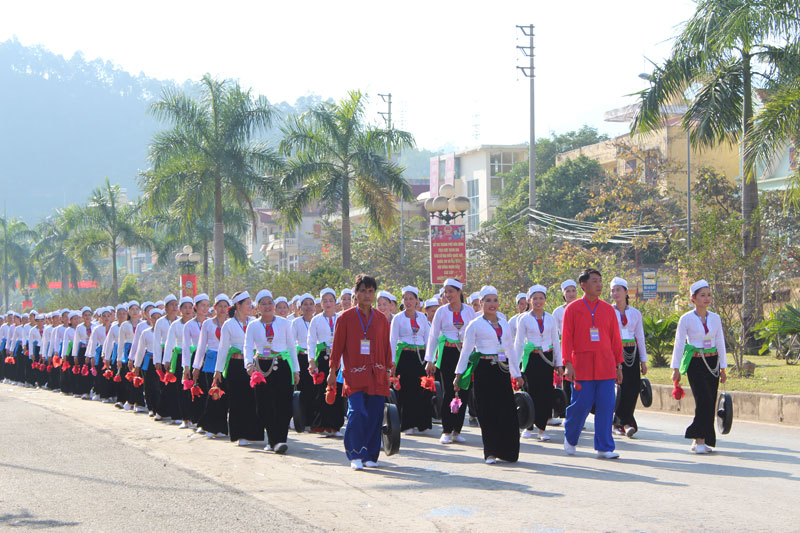
HBO – As of June 2018, the ethnic minority groups in Hoa Binh province owned a total of 786 intangible cultural heritages, according to statistics of the provincial Department of Culture, Sports and Tourism. More than ever, the preservation and promotion of heritage values need due attention.

Artists
perform at second Muong gong festival
Hoa Binh is home to six ethnic groups with their own cultural
characteristics, which helps form a diverse, unique and impressive culture of
Hoa Binh.
Basically, the local ethnic groups still maintain their
traditional customs. The values of heritages related to literature, spoken language
and handwriting (excluding Muong ethnic group) are conserved, while folk
knowledge and traditional costumes are kept at an average level. For example,
Muong people’s cultural values such as folk singing, gong art, and epic are well
preserved and appreciated. Stilt houses are fading away, but many localities
such as Lac Son and Tan Lac are building stilt houses using concrete instead of
wood as usual. Meanwhile, Tay people still keep their folk songs and maintain
the teaching and learning of ancient handwriting in the community. The Dao
ethnic group continues maintaining "cap sac” (maturity ritual), Tet nhay
(dancing ceremony), and ancient handwriting study, while Mong people still
preserve their costumes, housing architecture, forging, language, Tet (new
year) festival and khen (panpipe) festival.
Notably, some positive signs have been seen in recent time,
including the development of traditional festivals and Muong gong. The role of
Muong shamans has been improved in society.
Localities have paid attention to and invested in preserving and
promoting the values of intangible cultural heritages through the formation of
one traditional cultural village, dozens of community-based tourism cultural
villages at the provincial level, as well as the implementation of nearly 30
scientific projects on culture and ethnic groups, the organization of nearly 50
classes to teach folk arts, hundreds of classes on ancient handwriting, and the
restoration of 50 traditional festivals.
As of June, five ethnic minority groups in the province owned 786
intangible cultural heritages, including spoken language, handwriting,
literature, folk performance art, traditional festivals, handicrafts and folk
knowledge.
The provincial Party Committee and People’s Committee allowed to
collect, study and make scientific documents for two intangible cultural
heritages: Mo Muong and Muong gong, and consider the use of Muong alphabet. The
province will continue making a document on Mo Muong to submit to UNESCO in
order to seek its recognition as the Intangible Cultural Heritage in Need of Urgent
Safeguarding./.
The People’s Committee of Lac Son district held a ceremony on April 28 to receive the provincial relic certificate for the ancient rock carving site at Suoi Co stream, located in My Thanh commune.
A special music show titled "The country is in the fullness of joy” has been held at Hoa Binh Square in Hoa Binh city in celebration of the 50th anniversary of the liberation of the South and national reunification (April 30, 1975–2025).
The People's Committee of Lo Son commune, Tan Lac district, has organised the local annual traditional stream fishing festival on April 19 - 20.
As a land deeply intertwined with human history and Vietnam’s millennia-long journey of nation-building and defence, Hoa Binh is often revered for its epic tales and legends.
Residents of Hoa Binh boast a rich cultural identity, reflected in their unique language, traditional attire, customs, and folk melodies – described as "sweet as honey, clear as a mountain stream.”
Lac Son district’s Vu ban town held the 2025 Truong Kha temple festival on April 12–13 (the 15th–16th days of the third lunar month). Since its revival in 2019, the festival has been organised every three years, preserving valuable intangible heritage while meeting the community’s cultural and spiritual needs.



